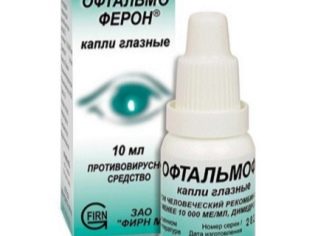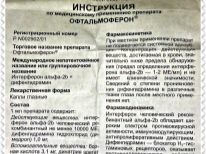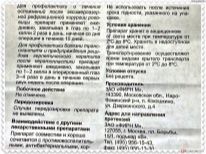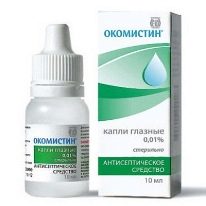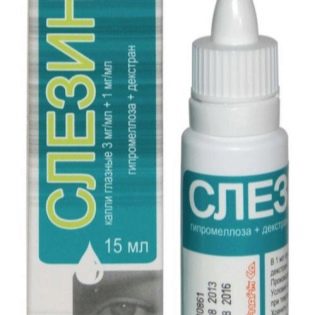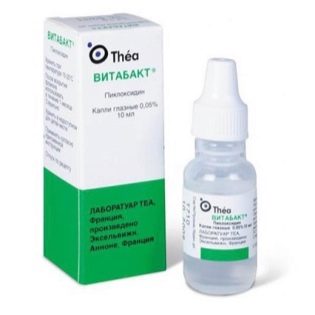Ophthalmoferon for children: instructions for use
Ophthalmoferon is often prescribed for adults with allergic or viral eye diseases. Thanks to several active ingredients, this local remedy has a multifaceted effect on the conjunctiva, and it does not have side effects. But is it possible to drip Ophthalmoferon in the eyes of children, when its use is justified and according to what scheme is this medication administered in childhood?
Release form
The drug is produced by the Russian company Firn M exclusively in the form of eye drops. One plastic or glass vial of Ophthalmoferon, which has a dropper cap, contains 10 milliliters of a colorless or slightly yellowish liquid.
Such a solution is completely transparent and normally should not contain any extraneous inclusions or suspensions. If the drug has become cloudy or has changed color, it is impossible to use such drops.
Composition
The main ingredient of Ophthalmoferon is human interferon, which belongs to the type of alpha 2. According to the method of its preparation, it is also called genetic engineering or recombinant, since genetic engineering is used for its formation.
Thanks to this production route, this component is more purified (by 99%) than interferon from leukocytes, and also cannot transmit viruses. Its amount in each milliliter of the solution is at least 10,000 IU.
The second active component of the drug is diphenhydramine, which is also known as "Dimedrol". One milliliter drop contains it in a dose of 1 mg.
So that the medicine is liquid and does not spoil, to it, in addition to sterile water, add other excipients, including Trilon B, boric acid, povidone and hypromellose. A complete list of such compounds is important to clarify when using drops in patients with allergy-prone patients.
Operating principle
Ophthalmoferon has a broad spectrum antiviral activity, as its ingredients affect different types of pathogens of viral infection.
In addition, the drug has such therapeutic effects:
- immunomodulatory;
- antimicrobial;
- local anesthetic;
- regenerating;
- anti-inflammatory.
The effect of droplets on the immune system and on viruses is provided by interferon, and by supplementing this ingredient with dimedrol (a histamine receptor blocker), the use of Ophthalmoferon also helps reduce itching and eliminate puffiness.
Auxiliary components of the droplets form the so-called "artificial tear." Among them are biological polymers that can protect the eye from irritating external influences. Due to their presence, the drug has a softening and lubricating effect.
In addition, their presence in the composition of Ophthalmoferon creates a protective film after treatment (the contact of the drug with the eye becomes longer) and helps to evenly distribute interferon and diphenhydramine over the surface of the epithelium.
Boric acid in the composition of the drug acts as an antiseptic, which is important when attaching a bacterial infection (secondary infection in viral eye diseases occurs quite often).
Studies have shown that treatment with Ophthalmoferon accelerates recovery from eye damage of a viral nature, promotes the resorption of infiltrates in the cornea, reduces soreness and redness.
Indications
The drug is used:
- with adenoviral conjunctivitis;
- with the defeat of the mucous membrane of the eye with herpes viruses;
- with hemorrhagic conjunctivitis caused by an enterovirus infection;
- with keratitis caused by herpes viruses or adenoviruses;
- With herpetic keratitis of different shapes;
- with keratouveuitis caused by the herpes viruses (including during the formation of ulcers);
- with keratoconjunctivitis, caused by adenoviruses or herpes infection;
- with eye damage from chickenpox;
- with dry eye syndrome;
- with bacterial infections of the conjunctiva (together with antibacterial agents);
- with allergic forms of conjunctivitis.
The drug can also be administered to patients who have undergone keratoplasty or other surgical treatment of the eye (to prevent complications after surgery).
At what age is it allowed to take?
The drug is considered harmless to patients of any age, so it can be dripped into the eyes of both infants and older children. In this case, the use of drops in both an infant and a schoolchild or teenager is recommended after a doctor's prescription.
Contraindications
The only reason why Ophthalmoferon cannot be used is considered to be individual intolerance to one of the active substances or auxiliary components of the drops. Other contraindications for such drugs are absent.
Side effects
Any negative extraneous effects during treatment Ophthalmoferon not noted.
The reason for the harmlessness of the drug is associated with its exclusively local effects. Even if a certain percentage of active substances penetrate the blood membranes into the blood, it is so small that it cannot be detected by any research, therefore it has no effect on health.
Instructions for use and dosage
If the stage of the disease is acute, the drug is injected into each eye up to 6-8 times a day, 1 drop, but depending on the severity of the disease, the doctor may prescribe Ophthalmoferon and 2 drops.
As soon as the inflammation begins to decrease, the frequency of using drops drops to 2-3 times a day.
The duration of use is determined individually, since Ophthalmoferon should be dripped until the signs of eye damage have completely disappeared.
If a patient has dry eye syndrome, the medication is prescribed for a course of 25-30 days and used daily. In each eye drip 1-2 drops Ophthalmoferon twice a day.
When prescribed after surgery on the eyes, the drug is instilled every day, starting from the day when there was surgery. Usually, the course of therapy lasts 10-14 days, and 1 or 2 drops of Ophthalmoferon drip 2-4 times a day into each eye.
Overdose
The manufacturer does not mention the cases of the negative impact on the patient's body of an overdose of drops.
Interaction with other drugs
Ophthalmoferon is often prescribed with corticosteroids, drugs to improve reparative processes, antibiotics and local anti-inflammatory drugs, since such drops are compatible with them and do not impair their therapeutic action.
The drug can also be used together with tear replacement therapy and agents that activate the regeneration of the membranes of the eye.
Terms of sale
Ophthalmoferon is an over-the-counter medicine, so buying it at a pharmacy does not cause any difficulties. The price of one bottle of drops varies from 250 to 310 rubles.
Storage features
The shelf life of a sealed vial is 2 years, but the opened medication can be dripped into the eyes only 30 days after the first use.
To store the medication (both sealed and already open bottle) requires a low temperature - from +2 to +8 degrees Celsius. The storage area must also be inaccessible to children and sunlight.
Reviews
Ophthalmoferon and doctors, and parents respond mostly well about the treatment of eye diseases in children. They emphasize that the positive effect of the drops appears within 1-2 days from the beginning of the instillation.
The advantages of the drug are the possibility of treating the smallest patients, good tolerability and a minimum list of contraindications. According to moms, no side effects cause drops, as well as any discomfort or burning after getting the drops in the eyes.
The disadvantages of Ophthalmoferon include a high frequency of use, the need to store in the refrigerator and the small shelf life of the opened bottle.
Some parents call the price of drops quite high and are interested in cheaper drugs. Also, sometimes there are reviews that complain about the lack of therapeutic effect.
Analogs
Other local agents may be used instead of Ophthalmoferon for eye diseases:
- Okomistin. Such antiseptic drops are analogue of Miramistin for eyes. They are prescribed to children of different ages, both for bacterial damage of eye tissue, and for viral infections. The drug can also be dripped into the nose.
- Okulohohel. Such a homeopathic remedy includes substances from echinacea, euphrasia and other plants. The drug is allowed at any age.
- Zovirax. Such an eye ointment based on acyclovir is used for the defeat of herpes viruses. It can be used from birth.
- Dex-Gentamicin. In this medicine, produced in the form of ointment and drops, contains an antibiotic supplemented with a glucocorticoid. In children, it is used only when prescribed by a doctor.
- Levomycetin. Such antibacterial drops are used for barley, blepharitis and other eye lesions by microbes. In childhood, they are used under the supervision of a physician from birth.
- Slezin. Such drops replace tears and can be used at any age.
- KromOGEKSAL. This medication based on sodium clomoglycate is prescribed for allergic eye damage. Children it is prescribed from 2 years.
- Sulfacyl sodium. Such a drug from the group of sulfonamides can be dripped to children from birth as a treatment. conjunctivitis, and for its prevention.
- Vitabact. This medicine with antimicrobic and antiseptic action is allowed in children from birth.
These and other eye drops or ointments are distinguished not only by the active components and age range, but also by the mechanism of action and contraindications. And therefore, they should be used for conjunctivitis or another eye disease in children only after the appointment of an ophthalmologist.
To drip into the eyes of a child without consulting a doctor is unacceptable.

